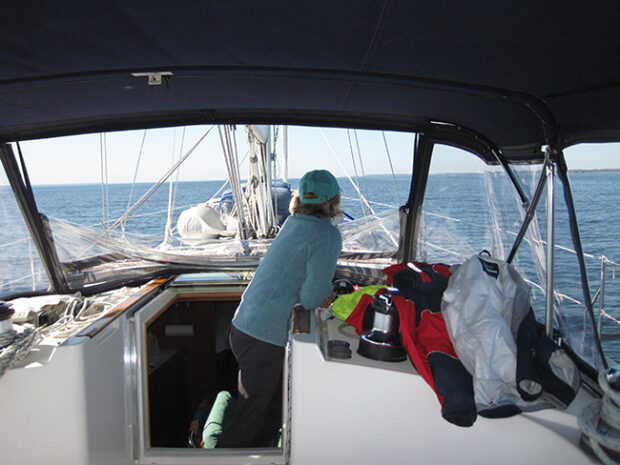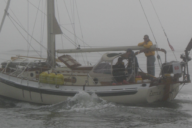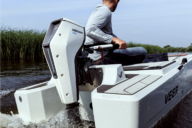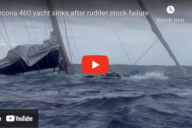In last week’s Just Cruising column, I posed the question of why more production cruising boats do not have hard dodgers or pilot houses as options, or even as standard equipment since we all have to deal with protection from the weather while cruising. Here are several good answers from CC readers. Many thanks to all for your input. GD
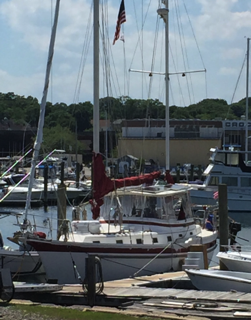
We built a custom hard top for our Endeavour E43 6 years ago and it added nearly 100 square feet of living space and a weatherproof navigation center that’s withstood 60+ knots. Built on a frame of 2.5” 6063 tubing, it’s a foam cored FRP structural panel strong enough to walk on and fasten our solar panels. Weight, approximately 350lbs.
Craig Hunter
If boat makers add hard dodgers to their designs, they will never be bluewater boats. You can’t use a hard dodger and beat with a windvane. It disturbs, if not blocks, the airflow to the vane.
Rich Lewis
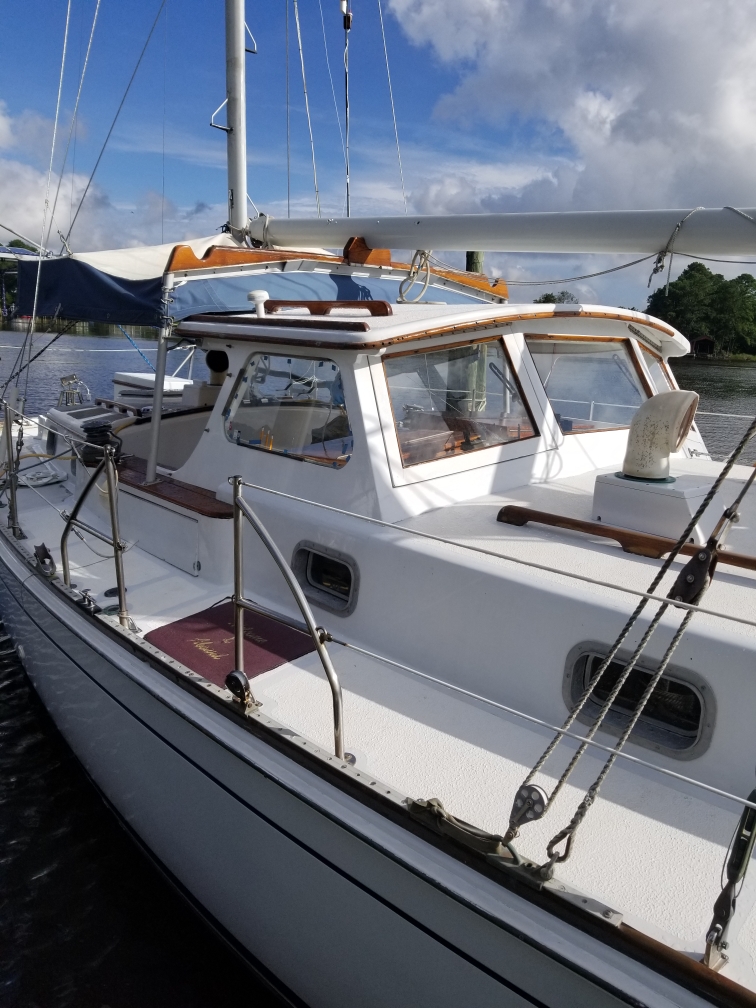
Yes, there is a place for hard dodgers on a cruising yacht. We should know since we have one on our Dickerson 41 that was built in 1976. A sistership to ours has a Sunbrella dodger like the one you describe. Over the years they have replaced it every five years or so at considerable cost. While the initial cost of building or retrofitting a hard dodger may appear to be prohibitively expensive, over time it will pay for itself.
More important than the cost, is the design of the hard dodger relative to the lines of the boat. Ours is in keeping with the low profile of the boat and doesn’t look like an afterthought. Plus it has opening windows that make it easier to open in warmer temperatures than the zippers on a Sunbrella dodger. There is a Sunbrella bimini that hangs off the aft end of the dodger and clips onto the shrouds. It tucks under the boom gallows if not needed.
Frankly, we’ve never understood why more boats don’t have hard dodgers.
Chris and Bill Burry, s/v Plover
Mathews, VA
Our last two boats were pilothouse cutters with both inside and outside steering. Between the two we cruised some 30,000 miles from Lake Superior through all five Great Lakes, down the St Lawrence River, around the Maritimes, and on down the coast to cruise the Bahamas and eastern Caribbean for eight seasons. After more than 50 years of sailboats, we now have a Downeast cruiser (power), but for cruising under sail we would never choose anything other than a great-sailing aft-cockpit configuration with a second helm station in the house. Both had exactly the same rig and sail plan as their standard aft-cockpit sister ships. Even in the tropics it was wonderful. Great ventilation & you’re not down in a cave while below having dinner in the extended Pilothouse. The new owners of our semi-custom aft-cockpit Tayana Vancouver 42 Pilothouse Cutter are currently readying to sail her to Europe, perhaps next year if COVID in fact settles down.
Bill Rohde
I saw your piece in Cruising Compass and couldn’t agree more. As I search for a boat to circumnavigate in, I’m often frustrated at how many things need to be retrofitted onto a boat off the line or even some more typical “blue water” boats. For sure, it seems bizarre to me that boats aren’t designed with biminis and dodgers in mind. It should come as an option! That way, the infrastructure can be set up to avoid odd and cumbersome stainless pole setups and weird areas where wind and rain still get in.
There are several boats I like that have the traveler in the cockpit, which is tough. I struggle to figure out how to create protection (as well as a dry/shady outdoor living space) with a traveler running right through the cockpit. While this is typically more on race/performance boats, I have seen it on the Italia, which suits my needs and checks off so many other boxes!
I understand that the number of boat buyers looking to live aboard is small, and manufacturers can’t cater to them, but at least in the case of the dodger and Bimini, there are few boat owners that don’t want that protection and outdoor living space.
Fair Winds,
Erica Conway
Ho-Ho-Kus, New Jersey
You raise a very pertinent question. The upstream question, however, is why you are out sailing in the first place. The two poles are: commercial (delivery) and enjoyment of nature.
I personally am firmly in the latter camp. I day sail-and short-haul cruise for the enjoyment of feeling wind and sun, while attending to the myriad challenges of sail trim, safe navigation, conversation with friends aboard and also attending to “hotel” needs such as lunch and drinks. I do that on a boat because of the environment, not in spite of it; the breeze in my hair (what is left of it!) and the sparkle of the sea. This said, I do have to be careful about direct sun; long history of skin cancers. But a Bimini is enough.
On the other hand, if I were a delivery skipper, or if I were forced by residency to sail in more blustery climes (North Sea, Southern Ocean), then an enclosed helm station is good. But that is a small corner of the market.
Thanks for giving us something great to read (and often, to act upon).
Yours, Nick Brown
Hmmm, like an Amel? Having sailed one, I can’t imagine going back, for the very reasons you articulated.
John W. Clanton
Amel 55

Hello George,
We have often thought the same thing. We purchased a Fisher 34 Pilothouse ketch because we thought it was the best choice for us sailing off the Oregon and Washington coast. The Pilothouse provides us the ability to be comfortable despite the outside conditions and very effectively lengthens our sailing season. We just moved to the Puget Sound area and expect that with our pilothouse we’ll be able to enjoy an almost year round season. When the weather is really nice, we have a tiller that can be slipped on to the rudder post allowing us to take the helm in the cockpit. Additionally, the Pilothouse provides an extra cabin with a great view to enjoy meals and companionship while anchored in a cool or wet anchorage.
Sincerely,
Jeff
Agree that most new production boats should have the factory option of a hard dodger.
Harold Kernodle
Amel has had hard dodgers as a fixture on their cruising boats for years. I have owned 2. The main problem I had was the difficulty of viewing the sails, especially at night.
I believe their newer boats have addressed this problem.
Jeffrey Rapp
Re Hard Dodger, I agree 100% with your comments on why is it designers don’t design a hard dodger as an option? My guess the boat builder is not interested in creating more work than needs to be to get the boat build and out of the yard and sold!
The problem as I have experienced looking around is even if you has one build custom dodger it will look tacked on and out of place on the boat’s lines. This can devalue the boat instead of increasing it. Cost of building a hard dodger is not cheap; the budget in Australia about $20K plus for a custom build one. The risk is that the finished produce could look like a bump on a log.
John Majewski s/v Skoiern
Australia

